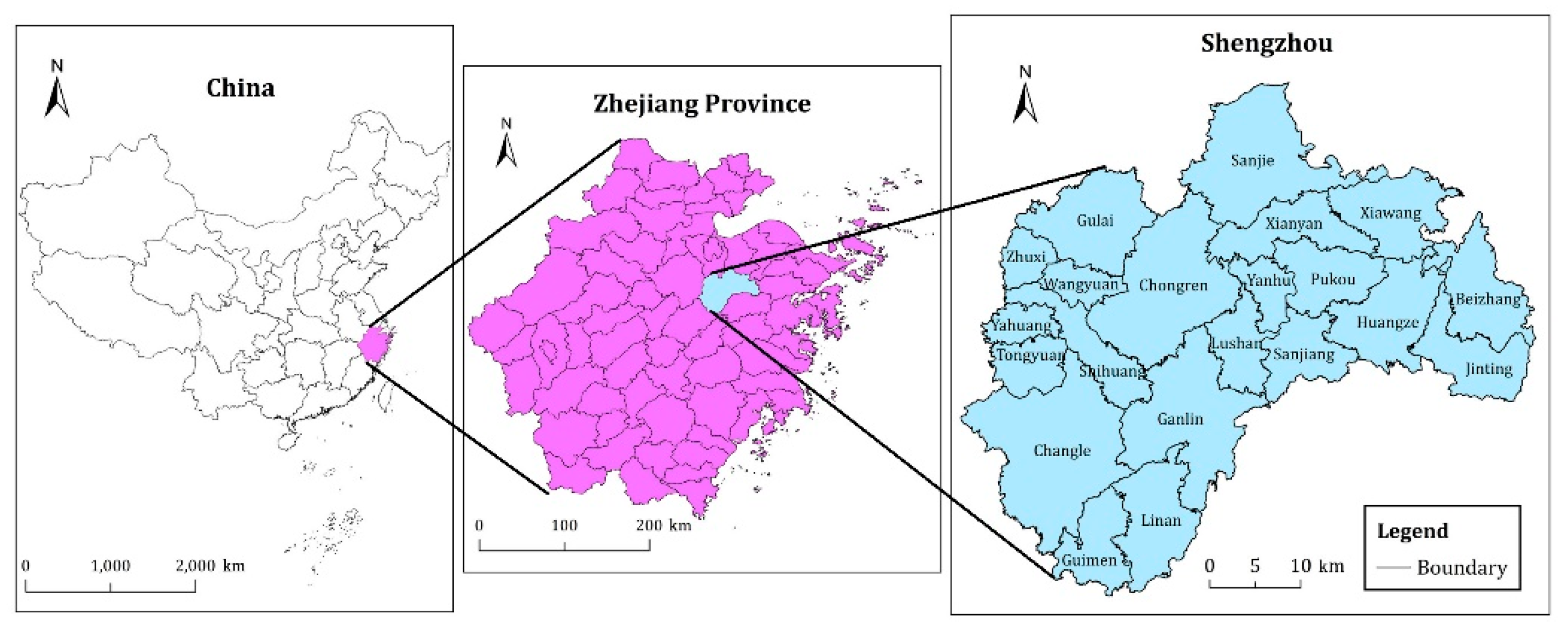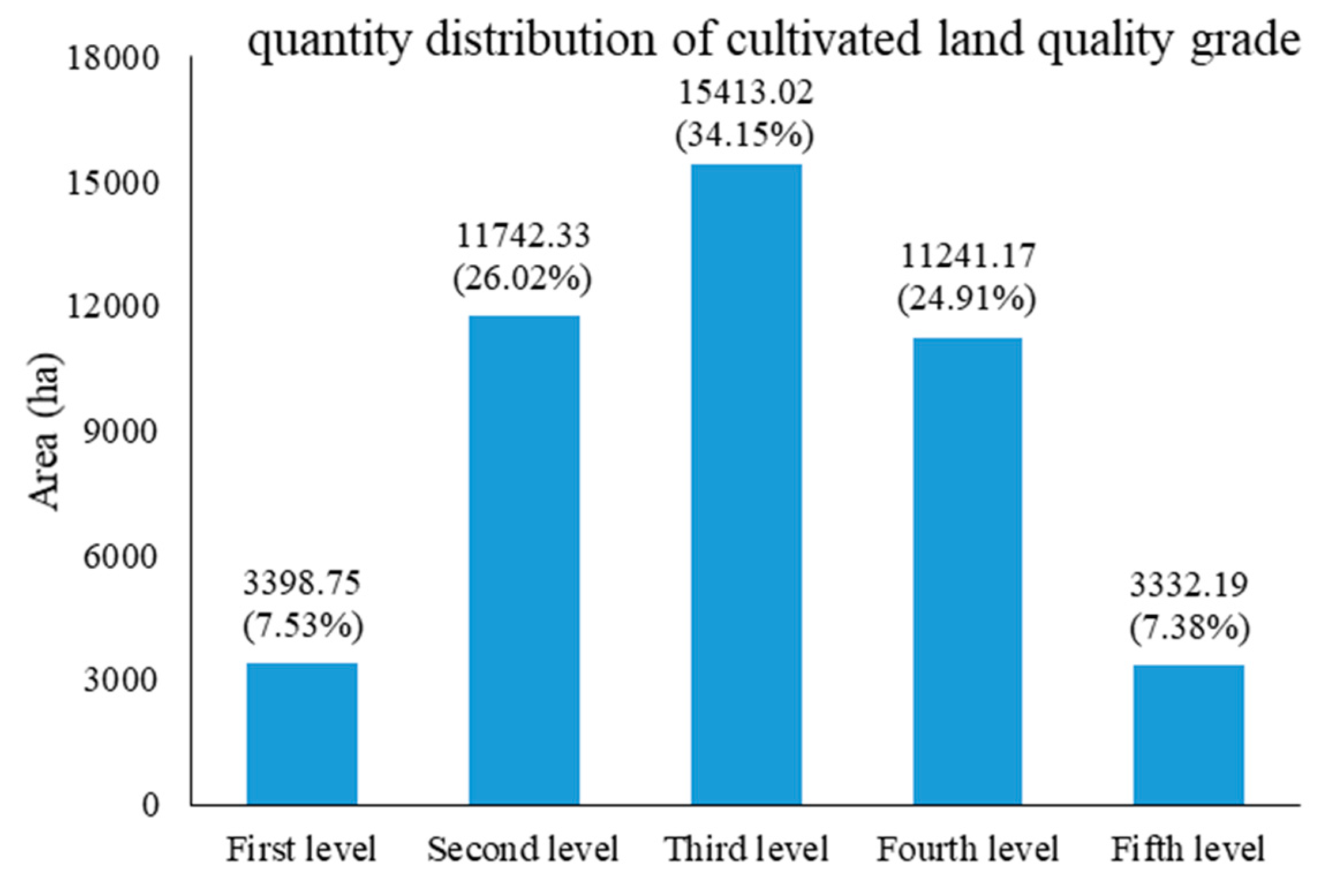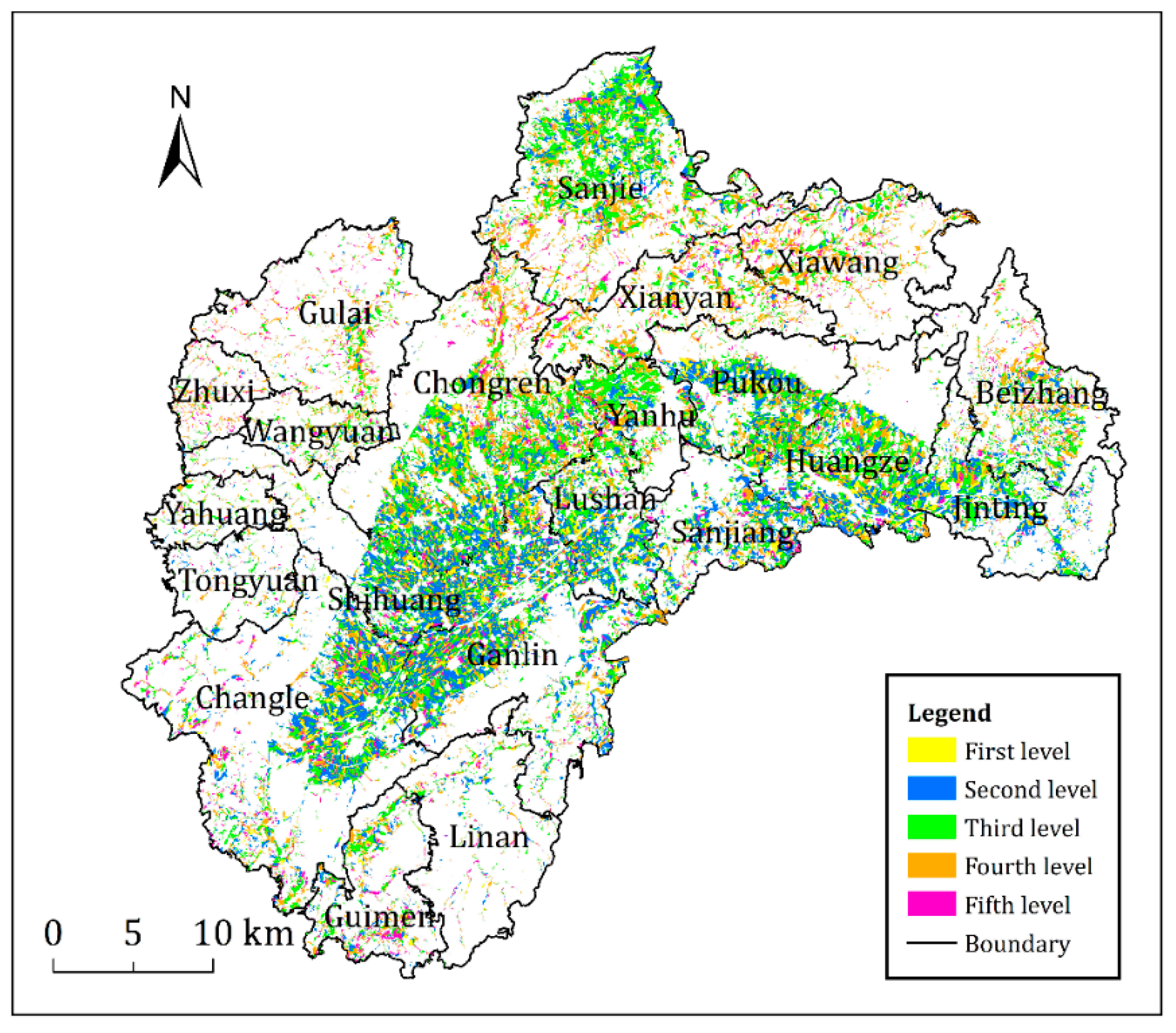Comprehensive Evaluation of Cultivated Land Quality at County Scale: A Case Study of Shengzhou, Zhejiang Province, China
Abstract
1. Introduction
2. Materials and Methods
2.1. Study Area
2.2. Data Collection and Processing
2.3. Methods
2.3.1. Comprehensive Evaluation Index System of Cultivated Land Quality and Index Weight
2.3.2. Standardisation of Comprehensive Evaluation Indicators for Cultivated Land Quality
2.3.3. Comprehensive Evaluation Model of Cultivated Land Quality
3. Results
3.1. Comprehensive Evaluation Results of Cultivated Land Quality
3.2. Regional Distribution of Cultivated Land Quality
3.3. Administrative Distribution Law of Cultivated Land Quality
4. Discussion
4.1. Construction of Cultivated Land Evaluation System
4.2. The Impact of Research Scale on Selection of Indicators
4.3. Research Prospect
5. Conclusions
Author Contributions
Funding
Acknowledgments
Conflicts of Interest
References
- Foley, J.A.; Ramankutty, N.; Brauman, K.A.; Cassidy, E.S.; Gerber, J.S.; Johnston, M.; Mueller, N.D.; O’Connell, C.; Ray, D.K.; West, P.C. Solutions for a cultivated planet. Nature 2011, 478, 337–342. [Google Scholar] [CrossRef] [PubMed]
- Francis, C.A.; Hansen, T.E.; Fox, A.A.; Hesje, P.J.; Nelson, H.E.; Lawseth, A.E.; English, A. Farmland conversion to non-agricultural uses in the US and Canada: Current impacts and concerns for the future. Int. J. Agric. Sustain. 2012, 10, 8–24. [Google Scholar] [CrossRef]
- Chai, J.; Wang, Z.; Yang, J.; Zhang, L. Analysis for spatial-temporal changes of grain production and farmland resource: Evidence from Hubei Province, central China. J. Clean. Prod. 2019, 207, 474–482. [Google Scholar] [CrossRef]
- Kuang, W.; Liu, J.; Dong, J.; Chi, W.; Zhang, C. The rapid and massive urban and industrial land expansions in China between 1990 and 2010: A CLUD-based analysis of their trajectories, patterns, and drivers. Landsc. Urban Plan. 2016, 145, 21–33. [Google Scholar] [CrossRef]
- Xu, X.; Wang, L.; Cai, H.; Wang, L.; Liu, L.; Wang, H. The influences of spatiotemporal change of cultivated land on food crop production potential in China. Food Secur. 2017, 9, 485–495. [Google Scholar] [CrossRef]
- Song, W.; Pijanowski, B.C. The effects of China’s cultivated land balance program on potential land productivity at a national scale. Appl. Geogr. 2014, 46, 158–170. [Google Scholar] [CrossRef]
- Kong, X. China must protect high-quality arable land. Nat. News 2014, 506, 7. [Google Scholar] [CrossRef]
- Xiao, Q.; Zong, Y.T.; Lu, S.G. Assessment of heavy metal pollution and human health risk in urban soils of steel industrial city (Anshan), Liaoning, Northeast China. Ecotoxicol. Environ. Safe 2015, 120, 377–385. [Google Scholar]
- Liu, Y.; Zhang, Y.; Guo, L. Towards realistic assessment of cultivated land quality in an ecologically fragile environment: A satellite imagery-based approach. Appl. Geogr. 2010, 30, 271–281. [Google Scholar] [CrossRef]
- Jiang, G.; Zhang, R.; Ma, W.; Zhou, D.; Wang, X.; He, X. Cultivated land productivity potential improvement in land consolidation schemes in Shenyang, China: Assessment and policy implications. Land Use Policy 2017, 68, 80–88. [Google Scholar] [CrossRef]
- Song, W.; Wu, K.; Zhao, H.; Zhao, R.; Li, T. Arrangement of high-standard basic farmland construction based on village-region cultivated land quality uniformity. Chin. Geogr. Sci. 2019, 29, 325–340. [Google Scholar] [CrossRef]
- Dumanski, J.; Pieri, C. Land quality indicators: Research plan. Agric. Ecosyst. Environ. 2000, 81, 93–102. [Google Scholar] [CrossRef]
- Tesfahunegn, G.B. Soil quality indicators response to land use and soil management systems in northern Ethiopia’s catchment. Land Degrad. Dev. 2016, 27, 438–448. [Google Scholar] [CrossRef]
- Vasu, D.; Srivastava, R.; Patil, N.G.; Tiwary, P.; Chandran, P.; Singh, S.K. A comparative assessment of land suitability evaluation methods for agricultural land use planning at village level. Land Use Policy 2018, 79, 146–163. [Google Scholar] [CrossRef]
- Ma, L.; Bo, J.; Li, X.; Fang, F.; Cheng, W. Identifying key landscape pattern indices influencing the ecological security of inland river basin: The middle and lower reaches of Shule River Basin as an example. Sci. Total Environ. 2019, 674, 424–438. [Google Scholar] [CrossRef]
- Teshome, A.; de Graaff, J.; Ritsema, C.; Kassie, M. Farmers’ perceptions about the influence of land quality, land fragmentation and tenure systems on sustainable land management in the north western Ethiopian highlands. Land Degrad. Dev. 2016, 27, 884–898. [Google Scholar] [CrossRef]
- Coyle, C.; Creamer, R.E.; Schulte, R.P.; O’Sullivan, L.; Jordan, P. A functional land management conceptual framework under soil drainage and land use scenarios. Environ. Sci. Policy 2016, 56, 39–48. [Google Scholar] [CrossRef]
- Land Consolidation Centre of Zhejiang Province. Guidelines for the Grading of Cultivated Land Quality and Agricultural Land Evaluation in Zhejiang Province in 2016; Publisher: Hangzhou, China, 2016. [Google Scholar]
- General Administration of Quality Supervision, Inspection and Quarantine of the People’s Republic of China; Standardisation Administration of the People’s Republic of China. Regulations for Classification on Agriculture Land of the People’s Republic of China; China Standard Press: Beijing, China, 2012. [Google Scholar]
- De la Rosa, D.; Mayol, F.; Diaz-Pereira, E.; Fernandez, M.; de la Rosa, D., Jr. A land evaluation decision support system (MicroLEIS DSS) for agricultural soil protection: With special reference to the Mediterranean region. Environ. Model. Softw. 2004, 19, 929–942. [Google Scholar] [CrossRef]
- Feng, Y.; Yang, Q.; Tong, X.; Chen, L. Evaluating land ecological security and examining its relationships with driving factors using GIS and generalized additive model. Sci. Total Environ. 2018, 633, 1469–1479. [Google Scholar] [CrossRef]
- Wilson, G.A. The spatiality of multifunctional agriculture: A human geography perspective. Geoforum 2009, 40, 269–280. [Google Scholar] [CrossRef]
- Nabahungu, N.L.; Visser, S.M. Farmers’ knowledge and perception of agricultural wetland management in Rwanda. Land Degrad. Dev. 2013, 24, 363–374. [Google Scholar] [CrossRef]
- Karnieli, A.; Qin, Z.; Wu, B.; Panov, N.; Yan, F. Spatio-temporal dynamics of land-use and land-cover in the Mu Us sandy land, China, using the change vector analysis technique. Remote Sens. 2014, 6, 9316–9339. [Google Scholar] [CrossRef]
- Sklenicka, P. Classification of farmland ownership fragmentation as a cause of land degradation: A review on typology, consequences, and remedies. Land Use Policy 2016, 57, 694–701. [Google Scholar] [CrossRef]
- Pineda, E.; Halffter, G. Species diversity and habitat fragmentation: Frogs in a tropical montane landscape in Mexico. Biol. Conserv. 2004, 117, 499–508. [Google Scholar] [CrossRef]
- Quality and Technology Supervision of Zhejiang Province. Technical Specifications for Assessment and Rating Criteria of Cultivated Land Quality; Quality and Technology Supervision of Zhejiang Province: Hangzhou, China, 2013. [Google Scholar]
- Bhardwaj, A.K.; Jasrotia, P.; Hamilton, S.K.; Robertson, G.P. Ecological management of intensively cropped agro-ecosystems improves soil quality with sustained productivity. Agric. Ecosyst. Environ. 2011, 140, 419–429. [Google Scholar] [CrossRef]
- Ren, T.; Wang, J.; Chen, Q.; Zhang, F.; Lu, S. The effects of manure and nitrogen fertilizer applications on soil organic carbon and nitrogen in a high-input cropping system. PLoS ONE 2014, 9, e97732. [Google Scholar] [CrossRef]
- Peerawat, M.; Blaud, A.; Trap, J.; Chevallier, T.; Alonso, P.; Gay, F.; Thaler, P.; Spor, A.; Sebag, D.; Choosai, C. Rubber plantation ageing controls soil biodiversity after land conversion from cassava. Agric. Ecosyst. Environ. 2018, 257, 92–102. [Google Scholar] [CrossRef]
- Nabiollahi, K.; Golmohamadi, F.; Taghizadeh-Mehrjardi, R.; Kerry, R.; Davari, M. Assessing the effects of slope gradient and land use change on soil quality degradation through digital mapping of soil quality indices and soil loss rate. Geoderma 2018, 318, 16–28. [Google Scholar] [CrossRef]
- Bünemann, E.K.; Bongiorno, G.; Bai, Z.; Creamer, R.E.; De Deyn, G.; de Goede, R.; Fleskens, L.; Geissen, V.; Kuyper, T.W.; Mäder, P. Soil quality—A critical review. Soil Biol. Biochem. 2018, 120, 105–125. [Google Scholar] [CrossRef]
- Reinhart, K.O.; Vermeire, L.T. Soil aggregate stability and grassland productivity associations in a northern mixed-grass prairie. PLoS ONE 2016, 11, e160262. [Google Scholar] [CrossRef]
- Pham, T.G.; Nguyen, H.T.; Kappas, M. Assessment of soil quality indicators under different agricultural land uses and topographic aspects in Central Vietnam. J. Soil Water Conserv. 2018, 6, 280–288. [Google Scholar] [CrossRef]
- Haydu-Houdeshell, C.; Graham, R.C.; Hendrix, P.F.; Peterson, A.C. Soil aggregate stability under chaparral species in southern California. Geoderma 2018, 310, 201–208. [Google Scholar] [CrossRef]
- De Paul Obade, V.; Lal, R. Assessing land cover and soil quality by remote sensing and geographical information systems (GIS). Catena 2013, 104, 77–92. [Google Scholar] [CrossRef]
- Liu, M.; Han, G.; Zhang, Q. Effects of soil aggregate stability on soil organic carbon and nitrogen under land use change in an erodible region in Southwest China. Int. J. Environ. Res. Public Health. 2019, 16, 3809. [Google Scholar] [CrossRef]
- Affandi, N.F.L.; Rusli, S.H.; Suhaini, A.M.; Baharulrazi, N. Effect of pH on Growth Rate and Yield of Cucumis sativus. Chem. Eng. 2018, 63, 133–138. [Google Scholar]
- Tyler, M.; Hunter, L.; Steiner, F.; Roe, D. Use of agricultural land evaluation and site assessment in Whitman County, Washington, USA. Environ. Manag. 1987, 11, 407–412. [Google Scholar] [CrossRef]
- Li, W.; Wang, D.; Li, H.; Liu, S. Urbanisation-induced site condition changes of peri-urban cultivated land in the black soil region of northeast China. Ecol. Indic. 2017, 80, 215–223. [Google Scholar] [CrossRef]
- Araya, A.; Stroosnijder, L. Assessing drought risk and irrigation need in northern Ethiopia. Agric. For. Meteorol. 2011, 151, 425–436. [Google Scholar] [CrossRef]
- Worqlul, A.W.; Jeong, J.; Dile, Y.T.; Osorio, J.; Schmitter, P.; Gerik, T.; Srinivasan, R.; Clark, N. Assessing potential land suitable for surface irrigation using groundwater in Ethiopia. Appl. Geogr. 2017, 85, 1–13. [Google Scholar] [CrossRef]
- Sun, J.; Li, Y.P.; Suo, C.; Liu, Y.R. Impacts of irrigation efficiency on agricultural water-land nexus system management under multiple uncertainties—A case study in Amu Darya River basin, Central Asia. Agric. Water Manag. 2019, 216, 76–88. [Google Scholar] [CrossRef]
- Jiang, R.; Lu, Q.; Peng, Z. A station-based rail transit network vulnerability measure considering land use dependency. J. Transp. Geogr. 2018, 66, 10–18. [Google Scholar] [CrossRef]
- Castella, J.; Manh, P.H.; Kam, S.P.; Villano, L.; Tronche, N.R. Analysis of village accessibility and its impact on land use dynamics in a mountainous province of northern Vietnam. Appl. Geogr. 2005, 25, 308–326. [Google Scholar] [CrossRef]
- Nagendra, H.; Southworth, J.; Tucker, C. Accessibility as a determinant of landscape transformation in western Honduras: Linking pattern and process. Landsc. Ecol. 2003, 18, 141–158. [Google Scholar] [CrossRef]
- Ludeke, A.K.; Maggio, R.C.; Reid, L.M. An analysis of anthropogenic deforestation using logistic regression and GIS. J. Environ. Manag. 1990, 31, 247–259. [Google Scholar] [CrossRef]
- Liu, Y.; Xue, J.; Gui, D.; Lei, J.; Sun, H.; Lv, G.; Zhang, Z. Agricultural Oasis Expansion and Its Impact on Oasis Landscape Patterns in the Southern Margin of Tarim Basin, Northwest China. Sustainability 2018, 10, 1957. [Google Scholar] [CrossRef]
- Imbrenda, V.; Coluzzi, R.; Lanfredi, M.; Loperte, A.; Satriani, A.; Simoniello, T. Analysis of landscape evolution in a vulnerable coastal area under natural and human pressure. Geomat. Nat. Hazards Risk 2018, 9, 1249–1279. [Google Scholar] [CrossRef]
- Wang, Z.; Chen, J.; Zheng, W.; Deng, X. Dynamics of land use efficiency with ecological intercorrelation in regional development. Landsc. Urban Plan. 2018, 177, 303–316. [Google Scholar] [CrossRef]
- Li, E.; Endter-Wada, J.; Li, S. Dynamics of Utah’s agricultural landscapes in response to urbanisation: A comparison between irrigated and non-irrigated agricultural lands. Appl. Geogr. 2019, 105, 58–72. [Google Scholar] [CrossRef]
- Chigbu, U.E.; Ntihinyurwa, P.D.; de Vries, W.T.; Ngenzi, E.I. Why Tenure Responsive Land-Use Planning Matters: Insights for Land Use Consolidation for Food Security in Rwanda. Int. J. Environ. Res. Public Health 2019, 16, 1354. [Google Scholar] [CrossRef]
- Li, L. Towards a protocol on fair compensation in cases of legitimate land tenure changes: Input document for a participatory process. J. Chin. Gov. 2018, 1, 124–127. [Google Scholar] [CrossRef]
- Kibblewhite, M.G.; Ritz, K.; Swift, M.J. Soil health in agricultural systems. Philos. Trans. R. Soc. B 2007, 363, 685–701. [Google Scholar] [CrossRef] [PubMed]



| Criteria | Index | Classification Standard | Index Weight | |||||||
|---|---|---|---|---|---|---|---|---|---|---|
| 100 | 90 | 80 | 70 | 60 | 50 | 40 | 30 | |||
| Natural quality | Tillage layer thickness/cm | ≥100 | 80–100 | 60–80 | 30–60 | <30 | 0.08 | |||
| Altitude/m | <50 | 50–150 | 150–300 | 300–500 | 500–800 | ≥800 | 0.09 | |||
| Soil texture | loam | silt loam /clay loam | loamy clay/sandy loam | clay | sand | 0.10 | ||||
| Soil organic matter/(g/Kg) | ≥30 | 25–30 | 20–25 | 15–20 | 10–15 | 5–10 | <5 | 0.08 | ||
| Soil pH | 6.0–7.0 | 5.8–6.0 /7.0–7.2 | 5.5–5.8 /7.2–7.5 | 5–5.5 /7.5–8 | <5/ >8 | 0.10 | ||||
| Utilisation conditions | Irrigation guarantee rate | ≥70 | 50–70 | 30–50 | <30 | 0.08 | ||||
| Road accessibility | ≥2.5 | 2.0–2.5 | 1.5–2.0 | <1.5 | 0.09 | |||||
| The impact degree of centre town | ≥70.5 | 58.0–70.5 | 45.5–58.0 | <45.5 | 0.08 | |||||
| Regularity of plots | ≤1.02 | 1.02–1.06 | 1.06–1.10 | 1.10–1.50 | >1.50 | 0.07 | ||||
| Ecological security | Slope | 0–2 | 2–6 | 6–15 | >15 | 0.08 | ||||
| NDVI | >0.45/ <0 | 0.35–0.45 | 0.25–0.35 | 0–0.25 | 0.08 | |||||
| Farmland connectivity | >80 | 50–80 | 40–50 | 40 | 0.07 | |||||
| Towns | First Level | Second Level | Third Level | Fourth Level | Fifth Level | Index Value | |||||
|---|---|---|---|---|---|---|---|---|---|---|---|
| Area/ha | PCT/% | Area/ha | PCT/% | Area/ha | PCT/% | Area/ha | PCT/% | Area/ha | PCT/% | ||
| Beizhang | 71.62 | 2.11 | 316.81 | 2.70 | 552.38 | 3.58 | 583.90 | 5.19 | 144.98 | 4.35 | 72.43 |
| Chongren | 442.23 | 13.01 | 1414.58 | 12.05 | 2432.36 | 15.78 | 1798.03 | 15.99 | 401.66 | 12.05 | 79.76 |
| Ganlin | 586.67 | 17.26 | 2239.12 | 19.07 | 1656.90 | 10.75 | 1054.52 | 9.38 | 426.80 | 12.81 | 80.41 |
| Gulai | 11.26 | 0.33 | 64.27 | 0.55 | 265.40 | 1.72 | 360.89 | 3.21 | 163.95 | 4.92 | 76.72 |
| Guimen | 59.01 | 1.74 | 178.20 | 1.52 | 306.81 | 1.99 | 250.34 | 2.23 | 175.40 | 5.26 | 75.73 |
| Huangze | 392.76 | 11.56 | 1034.47 | 8.81 | 1349.19 | 8.75 | 873.55 | 7.77 | 153.57 | 4.61 | 79.90 |
| Jinting | 199.92 | 5.88 | 639.02 | 5.44 | 640.86 | 4.16 | 271.53 | 2.42 | 84.50 | 2.54 | 78.04 |
| Linan | 15.38 | 0.45 | 96.12 | 0.82 | 131.54 | 0.85 | 104.36 | 0.93 | 55.46 | 1.66 | 76.35 |
| Lushan | 237.38 | 6.98 | 760.27 | 6.47 | 766.86 | 4.98 | 378.02 | 3.36 | 121.80 | 3.66 | 76.53 |
| Pukou | 212.22 | 6.24 | 677.29 | 5.77 | 724.65 | 4.70 | 444.02 | 3.95 | 66.89 | 2.01 | 77.43 |
| Sanjiang | 166.59 | 4.90 | 622.98 | 5.31 | 536.11 | 3.48 | 365.14 | 3.25 | 176.79 | 5.31 | 78.49 |
| Sanjie | 223.94 | 6.59 | 836.69 | 7.13 | 2268.24 | 14.72 | 1451.63 | 12.91 | 282.39 | 8.47 | 77.39 |
| Shihuang | 212.50 | 6.25 | 713.93 | 6.08 | 510.41 | 3.31 | 277.55 | 2.47 | 105.32 | 3.16 | 78.25 |
| Tongyuan | 2.90 | 0.09 | 69.86 | 0.59 | 68.46 | 0.44 | 64.81 | 0.58 | 20.81 | 0.62 | 77.41 |
| Wangyuan | 4.97 | 0.15 | 51.43 | 0.44 | 143.36 | 0.93 | 144.88 | 1.29 | 37.14 | 1.11 | 75.22 |
| Xiawang | 8.16 | 0.24 | 57.53 | 0.49 | 402.76 | 2.61 | 733.20 | 6.52 | 163.52 | 4.91 | 72.52 |
| Xianyan | 13.14 | 0.39 | 85.02 | 0.72 | 437.09 | 2.84 | 695.25 | 6.18 | 171.14 | 5.14 | 73.03 |
| Yahuang | 3.63 | 0.11 | 24.60 | 0.21 | 82.34 | 0.53 | 69.70 | 0.62 | 15.03 | 0.45 | 76.24 |
| Yanhu | 15.83 | 0.47 | 194.27 | 1.65 | 616.43 | 4.00 | 306.21 | 2.72 | 39.75 | 1.19 | 77.65 |
| Changle | 518.64 | 15.26 | 1655.22 | 14.10 | 1459.91 | 9.47 | 879.45 | 7.82 | 461.41 | 13.85 | 79.66 |
| Zhuxi | — | 0.00 | 10.65 | 0.09 | 60.96 | 0.40 | 134.22 | 1.19 | 63.88 | 1.92 | 70.83 |
| Total | 3398.75 | 100.00 | 11742.33 | 100.00 | 15413.02 | 100.00 | 11241.17 | 100.00 | 3332.19 | 100.00 | 78.08 |
© 2020 by the authors. Licensee MDPI, Basel, Switzerland. This article is an open access article distributed under the terms and conditions of the Creative Commons Attribution (CC BY) license (http://creativecommons.org/licenses/by/4.0/).
Share and Cite
Tan, Y.; Chen, H.; Lian, K.; Yu, Z. Comprehensive Evaluation of Cultivated Land Quality at County Scale: A Case Study of Shengzhou, Zhejiang Province, China. Int. J. Environ. Res. Public Health 2020, 17, 1169. https://doi.org/10.3390/ijerph17041169
Tan Y, Chen H, Lian K, Yu Z. Comprehensive Evaluation of Cultivated Land Quality at County Scale: A Case Study of Shengzhou, Zhejiang Province, China. International Journal of Environmental Research and Public Health. 2020; 17(4):1169. https://doi.org/10.3390/ijerph17041169
Chicago/Turabian StyleTan, Yongzhong, Hang Chen, Kuan Lian, and Zhenning Yu. 2020. "Comprehensive Evaluation of Cultivated Land Quality at County Scale: A Case Study of Shengzhou, Zhejiang Province, China" International Journal of Environmental Research and Public Health 17, no. 4: 1169. https://doi.org/10.3390/ijerph17041169
APA StyleTan, Y., Chen, H., Lian, K., & Yu, Z. (2020). Comprehensive Evaluation of Cultivated Land Quality at County Scale: A Case Study of Shengzhou, Zhejiang Province, China. International Journal of Environmental Research and Public Health, 17(4), 1169. https://doi.org/10.3390/ijerph17041169





